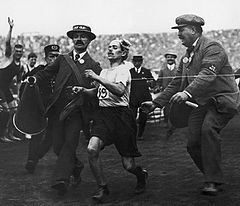Athletics at the 1908 Summer Olympics – Men's marathon
| Men's marathon at the Games of the IV Olympiad
|
|||||||||||||
|---|---|---|---|---|---|---|---|---|---|---|---|---|---|

Dorando Pietri finishes the marathon
|
|||||||||||||
| Venue | London | ||||||||||||
| Dates | 24 July | ||||||||||||
| Competitors | 27 from 11 nations | ||||||||||||
| Medalists | |||||||||||||
|
|||||||||||||
|
|
Johnny Hayes |
|
|
|---|---|---|---|
|
|
Charles Hefferon |
|
|
|
|
Joseph Forshaw |
|
The men's marathon race of the 1908 Summer Olympics took place in London on 24 July 1908. Johnny Hayes won after Dorando Pietri was disqualified for having received assistance before the finish line. For the first time in an Olympic marathon, the distance was 26 miles, 385 yards (42 195 m), which would become the standard distance in 1921. 75 competitors entered the race, of whom 55 from 16 nations started, with 27 from 11 nations finishing.
At a meeting of the International Olympic Committee in The Hague in May 1907 it was agreed with the British Olympic Association that the 1908 Olympics would include a marathon of about 25 miles or 40 kilometres.
The British Olympic Council handed responsibility for organising the Marathon to the Amateur Athletic Association, but they had no experience at organising a road race of such a length. In late 1907, an offer was made by Jack Andrew honorary secretary of the Polytechnic Harriers to take over the task. This was accepted in February 1908, though already, in November 1907, a route of "about 25 to 26 miles in distance" had been published in the newspapers, starting at Windsor Castle and finishing at the Olympic Stadium, the Great White City Stadium in Shepherd's Bush in London.
The Polytechnic Harriers were also tasked with organising a Marathon Trial Race, to be run along most of the Olympic Marathon route. By April 1908, a revised map of the course of the Trial Race was published, also showing the intended course of the Olympic Marathon. It had by this time been decided to fix the Olympic Marathon distance at "about 26 miles" to the stadium, plus a lap of the track (586 yards, 2 feet) (536 m), using the Royal Entrance as the marathon tunnel, and finishing at the normal stadium finishing-line in front of the Royal Box. The April 1908 map shows the intended finish, though the White City stadium was not yet complete at that time.
The full Olympic route was thus from Windsor, via Eton, Slough, Langley, Uxbridge, Ickenham, Ruislip, Harrow, Sudbury, Wembley, Willesden, and Wormwood Scrubs, to White City Stadium.
...
Wikipedia
